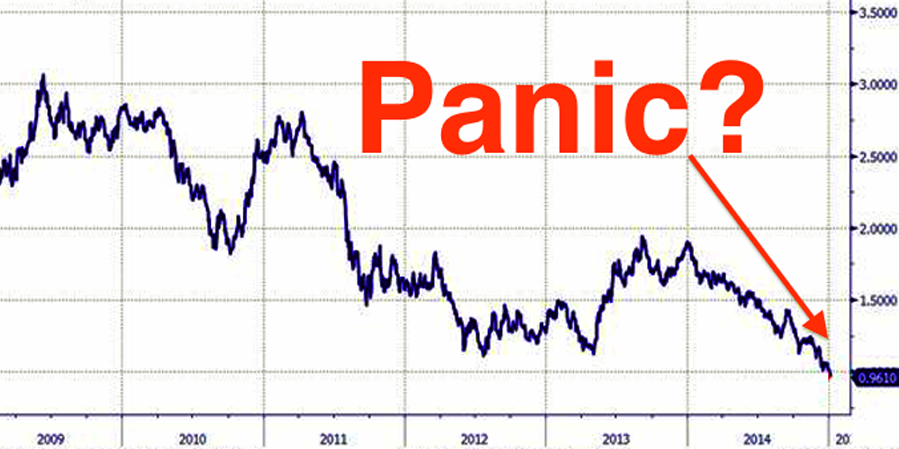Tips for crisis investing How to profit from panic
Post on: 15 Июль, 2015 No Comment

Share
Forget the investing mantra of buy low, sell high? Crisis investing offers opportunities to buy at tiny prices and sell for a profit
It’s the very basis for stock trading and has been repeated time and again for many decades, but it’s amazing how few people actually seem to understand the advice to buy low and sell high.
In fact, the very principle today can be called contrarian investing .
Stocks are at an all-time high, most valuation metrics look less attractive than they did in early 2007, and real estate prices in many cities around the world have climbed into an unsustainable bubble that even among the most bullish of analysts say will eventually pop.
Buy high, sell higher?
People keep still buying the highs, seemingly convinced that asset prices will climb even more – and they may be right. However, when the broader market finally bursts, and it will, these will be the same people caught in the mess and wishing they had changed their investment style a bit earlier.
Of course, there’s always a bull market somewhere. No matter how much the broader market declines, someone is making piles of money. Today, we’re going to do the opposite of the type of “permanent-bull” investors who buy stocks because they’re going higher.
By examining the mindset of the average person, it’s possible to learn how to benefit from their panic and purchase assets much closer to their lows.
Investors are people, too
To a large extent, markets are controlled by human emotion and susceptible to panic. Even algorithmic trading platforms are often programmed to sell a stock when it drops by a certain percentage over a certain period of time.
A contrarian investor realizes that because of the human element in stock markets, exaggerated declines are common and relatively easy to exploit. Let’s look at three examples of market panic and overreaction by shareholders.
Cruise chaos: Carnival Corporation
Carnival is the world’s largest operator of cruise ships. Each year, tens of thousands of people decide to vacation with them.
In January 2012, the Costa Concordia hit a rock and capsized off the coast of Italy. The result was 32 deaths, massive international media coverage – and a huge decline in Carnival’s stock.
Our FREE Offshore Strategy Session video makes it easy
Shares of Carnival plummeted by over 20 percent over the next several days following the crash, and investors were scared off by the negative publicity.
However, later that year, Carnival not only regained their losses but traded as high as 30% over their previous lows.
What happened? Investors simply overreacted. While the Costa Concordia’s sinking was a major tragedy, people realized that it would not cause long-term damage to Carnival’s bottom-line.
The loss of one cruise ship means little to a company with several dozen of them, and the accident was covered by insurance anyway. Negative publicity is forgotten quickly, and any damage to the company’s reputation would be short-lived.
In short, traders who bought shares in Carnival during the crisis were happy they did, and they have easily-frightened investors to thank.
BP: Bad press and British Petroleum
Most people reading are probably familiar with this next story. Back in April of 2011, the Deepwater Horizon oil rig operating in the Gulf of Mexico exploded, causing the largest oil spill in history and an estimated 4.9 million barrels of oil to pour into the ocean.

Public enemy number one for the next several months was British Petroleum, and the company’s stock tanked. Four days before the spill, shares of BP traded at $59.88 a share. By June of 2011, the stock declined by over 50 percent to reach a low of $27.02 per share.
But it was soon confirmed that investors had overreacted once again. In January of the following year, the stock was back up to almost $50. Those who bought after the oil spill almost doubled their money in less than six months.
With that said, the stock to this day has not yet recovered to its pre-2011 highs. The reason for this may be because unlike Carnival, BP shareholders actually had something to worry about. The company has paid billions of dollars worth of settlements, and is in fact, still paying them.
The point remains. Shareholders miscalculated how much the crisis would affect BP, and contrarian investors ended up making huge profits.
Reputation recovery: AirAsia
The last and most recent example is AirAsia. In December of 2014, AirAsia Flight 8501 lost contact with air traffic control while en route from Indonesia to Singapore. It was later found at the bottom of the sea, and all 162 people on board the plane had died.
The next trading day, AirAsia shares plummeted by over 8 percent. During the course of the following week, the stock was down more than 15 percent from its price before the crash.
As with most stories that are similar to this one, it was proven that investors panicked too much. Not much longer than a month later, the stock is near its all-time once more.
While the negative publicity may have dealt a short-term blow to the company’s reputation, the crash was the first one in AirAsia’s history. It may not have a flawless record anymore, but then again, not many airlines do.
The fact that stock declined by such a large amount while oil prices are so low is even more bizarre. Businesses such as AirAsia are making more profit than they have in a long time and despite the crash, most economic factors are looking very positive for the company.
The message is clear. Markets are controlled by people, and people are easily scared off by bad news. The next time you read a headline telling you that a company has suffered a major accident, consider buying its stock while others are jumping ship.
Nomad Capitalist editor Andrew Henderson has put together a no-holds-barred Strategy Session with the most important things you need to know about international diversification. If you want to get the Millionaire’s Toolkit of offshore strategies, click here to get your free Strategy Session.














